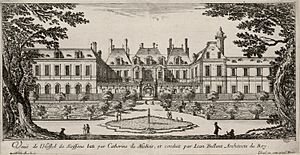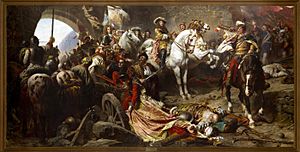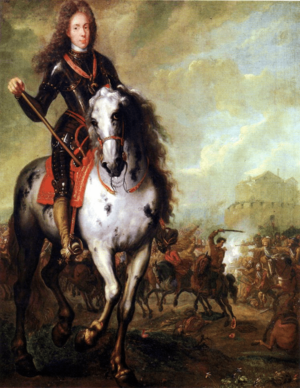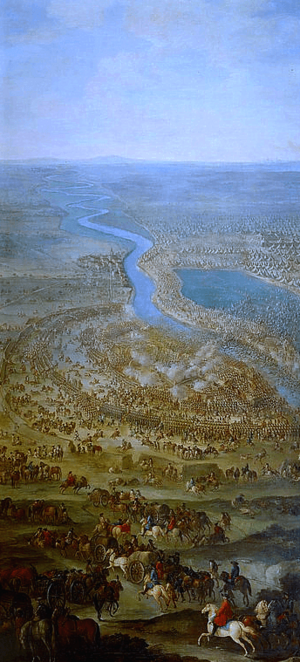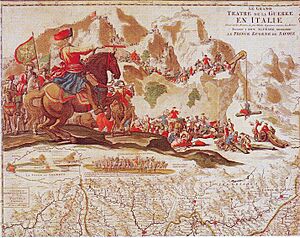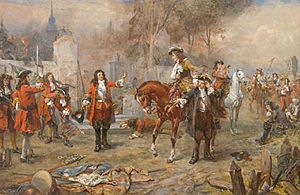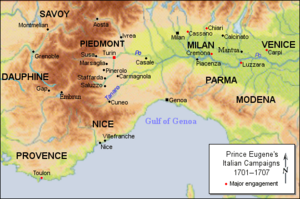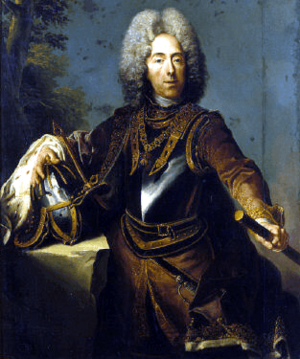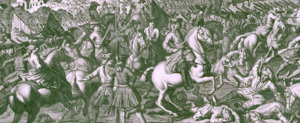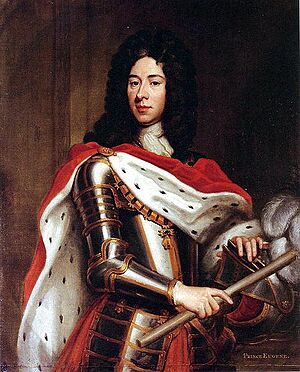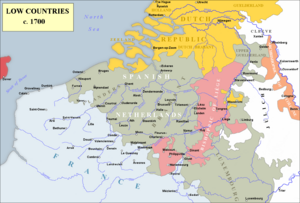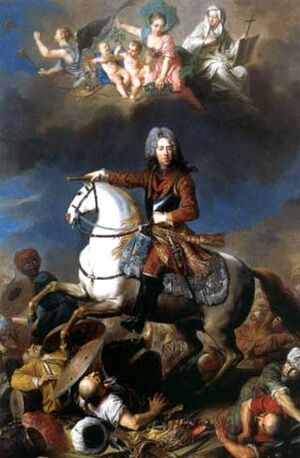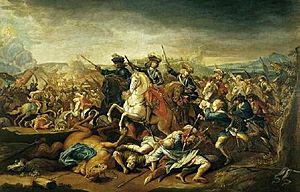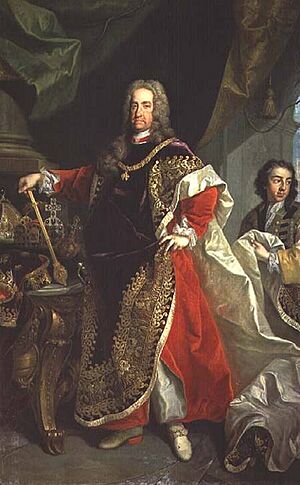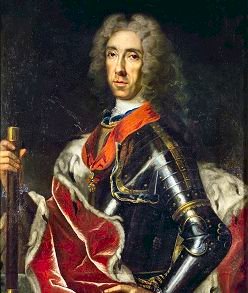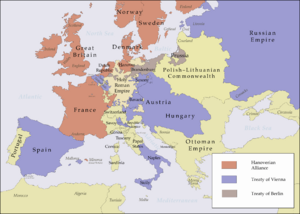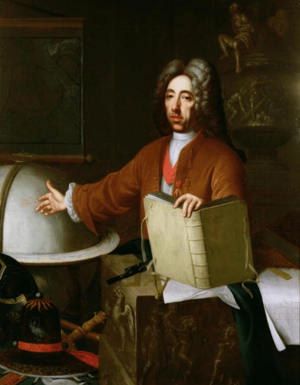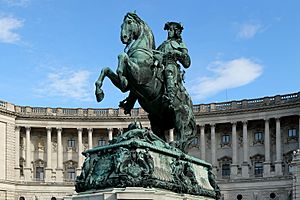Prince Eugene of Savoy facts for kids
Quick facts for kids Eugene of Savoy |
|
|---|---|
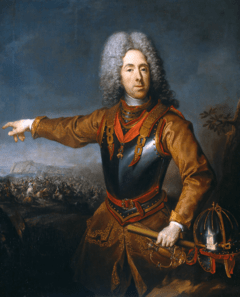
Portrait of Prince Eugene of Savoy, 1718
by Jacob van Schuppen |
|
| Born | 18 October 1663 Hôtel de Soissons, Paris, France |
| Died | 21 April 1736 (aged 72) Vienna, Austria |
| Burial | St. Stephen's Cathedral, Vienna |
| House | Savoy-Carignano |
| Father | Eugene Maurice of Savoy |
| Mother | Olympia Mancini |
| Signature | |
| Military career | |
| Rank | Field marshal |
| Conflicts |
Battle of Vienna (1683)
Siege of Buda (1684) Siege of Buda (1686) Battle of Mohács (1687) Siege of Belgrade (1688) Battle of Zenta (1697) Battle of Carpi (1701)
Battle of Chiari (1701) Battle of Cremona (1702) Battle of Luzzara (1702) Battle of Blenheim (1704) Battle of Cassano (1705) Siege of Turin (1706) Battle of Toulon (1707) Battle of Oudenarde (1708) Siege of Lille (1708) Battle of Malplaquet (1709) Battle of Denain (1712) Rhine campaign (1713) Battle of Petrovaradin (1716)
Siege of Temeşvar (1716) Battle of Belgrade (1717) Siege of Philippsburg (1734)
|
Prince Eugene Francis of Savoy–Carignano (born October 18, 1663 – died April 21, 1736), often called Prince Eugene, was a famous military leader. He became a field marshal in the army of the Holy Roman Empire and the Austrian Habsburg dynasty. He lived during the late 1600s and early 1700s.
Eugene was one of the most successful army commanders of his time. He rose to very high positions in the Emperor's court in Vienna. He was born in Paris, France, and grew up in the court of King Louis XIV of France.
Even though he was expected to become a priest, Eugene decided to join the army at age 19. King Louis XIV refused to let him join the French army. So, Eugene moved to Austria and offered his loyalty to the Holy Roman Empire instead.
During his long career, Eugene served three Holy Roman Emperors: Leopold I, Joseph I, and Charles VI. He first fought against the Ottomans at the Siege of Vienna in 1683. His big win against the Ottomans at the Battle of Zenta in 1697 made him famous across Europe.
Eugene became even more well-known during the War of the Spanish Succession. He worked with the Duke of Marlborough. Together, they won major battles against the French at Blenheim (1704), Oudenarde (1708), and Malplaquet (1709). He also had success in Italy, especially at the Battle of Turin (1706).
Later, he fought the Ottomans again in the Austro-Turkish War. He won battles at Petrovaradin (1716) and the important Siege of Belgrade in 1717. Prince Eugene helped save the Habsburg Empire from French control. He also stopped the Ottomans from moving further into Europe. Today, many beautiful buildings in Vienna show his support for the arts.
Contents
Early Life and Military Start (1663–1699)
Childhood in Paris
Prince Eugene was born in Paris on October 18, 1663. His mother, Olympia Mancini, was a niece of Cardinal Mazarin. She was brought to Paris from Rome to help her family's standing. Olympia grew up with the young King Louis XIV.
Olympia married Eugene Maurice, a French general. They had five sons, with Eugene being the youngest. Their parents did not spend much time with the children. Their father was often away fighting. Their mother was busy with court life.
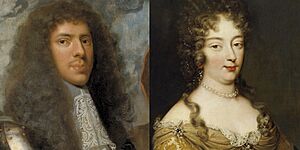
Olympia later faced problems at court and left France in 1680. Eugene was then cared for by his grandmother and aunt. From age ten, Eugene was expected to become a priest. This was common for the youngest sons in noble families. However, Eugene was not very tall or strong.
Joining the Army
In February 1683, at age 19, Eugene decided he wanted to be a soldier. He asked King Louis XIV to let him lead a French army company. But the King refused him. Louis XIV had not been kind to Olympia's children since her troubles. He said Eugene was too bold.
This decision by Louis XIV would cost him greatly later on. Prince Eugene, working with the Duke of Marlborough, would defeat the French army at Blenheim. This battle stopped France's military power.
Since France would not let him join its army, Eugene looked elsewhere. His brother, Louis Julius, had joined the Imperial army in Austria. But he was killed fighting the Ottoman Empire in 1683. When Eugene heard this, he decided to go to Austria. He hoped to take over his brother's command. His cousin, Louis of Baden, was already a top general in the Imperial army. On July 26, 1683, Eugene left Paris for Austria.
Fighting the Ottomans
By May 1683, the Ottoman Empire was a big threat to Vienna, the capital of Emperor Leopold I. A large Ottoman army of up to 200,000 men invaded Hungary. About 90,000 of them soon surrounded Vienna. Emperor Leopold I fled to Passau for safety. Eugene arrived at Leopold I's camp in mid-August.
Eugene was not Austrian, but he had some family ties to the Habsburgs. His grandfather was the son of a Spanish princess. More importantly, Eugene was a cousin of Victor Amadeus, the Duke of Savoy. The Emperor hoped this connection would be useful against France. Eugene was welcomed and given a position in the Imperial army. He spoke Italian with the Emperor and understood German well.
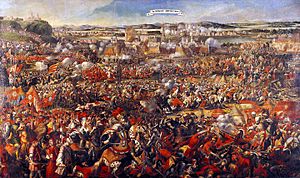
Eugene's loyalty was tested right away. In September, Imperial forces and a Polish army joined together. They were led by the Duke of Lorraine and King John III Sobieski. On September 12, the Christian armies attacked the Ottoman camp. The Battle of Vienna lasted all day. It ended the 60-day siege, and the Ottoman forces were defeated. Eugene, serving as a volunteer, fought bravely. He earned praise from Lorraine and the Emperor. He was later made a colonel.
The Holy League
In March 1684, Leopold I formed the Holy League. This alliance with Poland and Venice aimed to stop the Ottoman threat. For the next two years, Eugene continued to show his skill as a soldier. By the end of 1685, at just 22 years old, he became a Major-General.
In June 1686, the Duke of Lorraine besieged Buda (Budapest). This city was the center of Ottoman control in Hungary. After 78 days, Buda fell on September 2. Ottoman resistance weakened across the region. More success came in 1687. Eugene led a cavalry brigade and helped win the Battle of Mohács on August 12. The Ottomans were so badly beaten that their army rebelled. The Sultan, Mehmed IV, was removed from power. Eugene's bravery was noticed again. He was given the honor of telling the Emperor in Vienna about the victory. In November 1687, Eugene was promoted to Lieutenant-General. He also received the Order of the Golden Fleece from King Charles II of Spain.
In 1688, Eugene was wounded in the knee during the Siege of Belgrade. He did not return to active duty until January 1689.
Nine Years' War (1689–1697)
While Imperial forces were fighting the Ottomans in the east, French troops crossed the Rhine into the Holy Roman Empire in the west. King Louis XIV hoped to quickly settle his disputes with German princes. But his actions only made the Germans stronger. In May 1689, Leopold I and the Dutch formed an alliance against France.
Eugene first fought on the Rhine with Max Emanuel. He then moved to Piedmont after his cousin, Victor Amadeus, joined the alliance against France in 1690. Eugene was promoted to general of cavalry. He arrived in Turin with his friend, the Prince of Commercy. However, things did not start well. Against Eugene's advice, Amadeus fought the French at Staffarda and lost badly. Only Eugene's skill with the cavalry saved his cousin from disaster.
Eugene was not happy with the soldiers and their leaders in Italy. He even threatened to leave Imperial service. But the Emperor was impressed by Eugene's dedication. In 1693, he promoted Eugene to Field-Marshal. Victor Amadeus later made a secret deal with Louis XIV. By 1696, Amadeus switched sides and joined the French. Eugene never fully trusted his cousin again.
The French commander, Marshal Catinat, won many honors in Italy. But Eugene, who wanted action and results, gained a better reputation from the war. The Treaty of Ryswick in 1697 ended the war in the west. This allowed Leopold I to focus all his efforts on defeating the Ottoman Turks in the east.
Victory at Zenta
The war against Louis XIV had allowed the Turks to recapture Belgrade in 1690. In 1691, the Austrians, led by Louis of Baden, won a big victory against the Turks at the Battle of Slankamen. This secured Habsburg control of Hungary. When Baden moved west in 1692, his replacements were not as effective. In April 1697, 34-year-old Eugene was given supreme command of the Imperial forces. This was Eugene's first time leading an army on his own. He found his army in a very bad state. Eugene, with help from Commercy, quickly brought order and discipline back.
Emperor Leopold I had told Eugene to be very careful and avoid risks. But when Eugene learned that Sultan Mustafa II was marching towards Transylvania, he decided to attack. He moved to stop the Turks as they crossed the River Tisza at Zenta on September 11, 1697.
The Imperial army attacked late in the day. The Ottoman cavalry had already crossed the river. Eugene decided to attack right away, forming his men in a half-moon shape. The attack was so strong that it caused panic among the Turks. By nightfall, the battle was won. Eugene's army lost about 2,000 men. But he had completely defeated the enemy, killing about 25,000 Turks. This included the Grand Vizier, Elmas Mehmed Pasha. Eugene had destroyed the Ottoman army and ended the War of the Holy League.
After a quick raid into Ottoman Bosnia, Eugene returned to Vienna in November. He received a hero's welcome. His victory at Zenta made him a European hero. He was given land in Hungary, which brought him a good income. This allowed him to enjoy art and architecture.
The Battle of Zenta was the most important victory in the long war against the Turks. With Leopold I now focused on Spain, the Emperor ended the conflict with the Sultan. They signed the Treaty of Karlowitz on January 26, 1699.
Middle Life and Major Wars (1700–1720)
War of the Spanish Succession
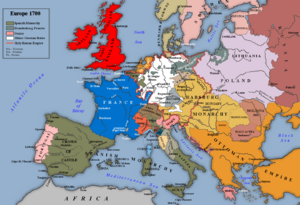
When Charles II of Spain died without children in 1700, the Spanish throne became a big problem. Charles II had left his entire empire to Louis XIV's grandson, Philip, Duke of Anjou. This could have united the Spanish and French kingdoms under the House of Bourbon. England, the Dutch Republic, and Leopold I could not accept this. Leopold I had his own claim to the Spanish throne. He decided to send an army to take Spanish lands in Italy.
Eugene crossed the Alps with about 30,000 men in May/June 1701. He used clever moves to defeat the French commander Catinat at the Battle of Carpi on July 9. Louis XIV wrote to his commander, "I have warned you that you are dealing with an enterprising young prince; he does not tie himself down to the rules of war." On September 1, Eugene defeated Catinat's replacement, Marshal Villeroi, at the Battle of Chiari.
Eugene often faced challenges from both the enemy and his own government in Vienna. He lacked supplies, money, and men. This forced him to use unusual tactics. In a daring raid on Cremona on January 31, 1702, Eugene captured the French commander-in-chief. This caused a stir in Europe. However, Vienna did not send the help Eugene needed. This forced him to seek another battle. The Battle of Luzzara on August 15 was not a clear win. Eugene's forces caused more casualties to the French, but the battle did not settle much. Eugene held his position south of the Alps. With his army struggling, Eugene returned to Vienna in January 1703.
Leading the War Council
Eugene's reputation in Europe grew, but his 1702 campaign had not been a full success. Austria was now in danger. The Elector of Bavaria had sided with the French. A revolt had also started in Hungary. The monarchy was running out of money. Leopold I finally agreed to change the government. In June 1703, Prince Eugene became the new President of the Imperial War Council.
As head of the war council, Eugene was now part of the Emperor's inner circle. He was the first president to also be an active commander. He quickly worked to make the army more efficient. He sent encouragement and money to commanders. Promotions were given based on service, not connections. Discipline improved. But Austria still faced many threats in 1703. French forces threatened Vienna, and a large French army was in northern Italy. A Hungarian revolt also spread quickly.
Blenheim Victory
In 1703, arguments between French commanders prevented an attack on Vienna. But France and Spain still expected Vienna to fall. The Imperial ambassador in London asked for Anglo-Dutch help. Only a few leaders in England and the Dutch Republic understood how serious Austria's danger was. The most important of these was the English Captain-General, the Duke of Marlborough.
By early 1704, Marlborough decided to march south to help Germany and the Danube region. He specifically asked for Eugene to join him. The two commanders met for the first time on June 10. They quickly became good friends. This strong bond helped them win many battles together. The first and most famous victory was the Battle of Blenheim on August 13, 1704. Eugene led the right side of the Allied army. He held off the stronger forces of the Elector of Bavaria and Marshal Marsin. Meanwhile, Marlborough broke through the French center. The French suffered over 30,000 casualties. This battle saved Vienna and forced Bavaria out of the war. Both commanders praised each other. Eugene's actions were crucial for the Allied success.
In Europe, Blenheim is seen as much Eugene's victory as Marlborough's. France now faced the risk of invasion. But Leopold I in Vienna still had problems. The Hungarian revolt was a big threat. Also, French forces in northern Italy were still strong. Only Turin, the capital of Savoy, was holding out.
Turin and Toulon
Eugene returned to Italy in April 1705. But French commander Vendôme stopped his attempts to move towards Turin. Eugene's army was outnumbered and lacked supplies. He suffered a defeat at the Battle of Cassano on August 16. After Leopold I died and Joseph I became Emperor in May 1705, Eugene finally got the support he needed. Joseph I strongly backed Eugene in military matters. He was the Emperor Eugene was happiest serving. Joseph I convinced Eugene to return to Italy and restore Austria's honor.
Eugene arrived in Italy in mid-April 1706. He helped organize a retreat for the Austrian army after their defeat by Vendôme. Vendôme then prepared to defend his lines to keep Eugene stuck in the east. Meanwhile, another French general threatened Turin. Eugene tricked the French commander. He pretended to attack along one river, then moved south across the Po in mid-July. This outsmarted the French and allowed him to move towards Piedmont to help Turin.
Events elsewhere changed the war in Italy. Marlborough's big win at the Battle of Ramillies on May 23 led Louis XIV to call Vendôme back to Flanders. The Duke of Orléans replaced Vendôme in Italy. But French indecision led to their downfall. Eugene joined forces with Victor Amadeus in early September. On September 7, they attacked and decisively defeated the French forces besieging Turin. Eugene's victory broke France's control over northern Italy. The entire Po valley came under Allied control. Marlborough wrote, "It is impossible for me to express the joy it has given me; for I not only esteem but I really love the prince."
The Austrian victory in Italy led to Austrian rule in Lombardy. Eugene became the Governor of Milan. But the next year, 1707, was a disappointment. The Emperor and Eugene agreed to Marlborough's plan to attack Toulon, a major French naval base. However, the Allied commanders did not work well together. Eugene felt the attack was not practical. French reinforcements ended the plan. On August 22, 1707, the Imperial army retreated. The failure of the Toulon attack meant no quick end to the war that year.
Oudenarde and Malplaquet
In 1708, Eugene avoided being sent to Spain. This allowed him to command the Imperial army on the Moselle and join Marlborough in the Spanish Netherlands. Eugene arrived at the Allied camp in early July. His presence boosted morale after two cities had sided with the French. The Allied commanders planned a bold attack on the French army. On July 10, the Anglo-Dutch army marched quickly to surprise the French. The ensuing battle on July 11 was a big success for the Allies. Eugene led the important right flank and center. He and Marlborough worked very well together. Marlborough wrote, "Prince Eugene and I shall never differ about our share of the laurels."
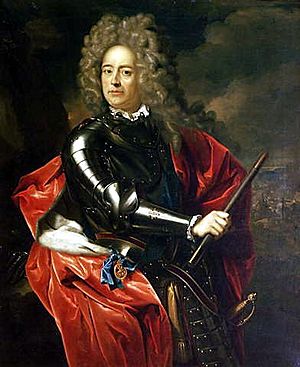
Marlborough wanted to march directly on Paris. But the Dutch and Eugene preferred a more careful approach. Marlborough agreed, and they decided to besiege Vauban's great fortress, Lille. Eugene oversaw the siege of the town, which surrendered on October 22. The citadel held out until December 10. Despite difficulties (Eugene was wounded), the 1708 campaign was a great success. The French were driven out of almost all the Spanish Netherlands. Eugene wrote, "He who has not seen this has seen nothing."
Recent defeats and a harsh winter caused great hardship in France. Louis XIV was close to accepting peace terms. But the Allies demanded that Louis XIV use his own troops to remove Philip V from the Spanish throne. This was unacceptable to the French. Neither Eugene nor Marlborough wanted the war to continue. But the French King offered no new proposals. Eugene wrote to the Emperor in June 1709, "There can be no doubt that the next battle will be the biggest and bloodiest that has yet been fought."
After capturing Tournai, the Allied generals focused on Mons. Marshal Villars fortified his position southwest of the town. Marlborough and Eugene wanted to attack before Villars' defenses became too strong. They waited for reinforcements, which gave the French more time to prepare. The Battle of Malplaquet, fought on September 11, 1709, was the bloodiest battle of the war. On the left, the Prince of Orange led his Dutch infantry in costly charges. Eugene also attacked and suffered heavy losses. But constant pressure forced Villars to weaken his center, allowing Marlborough to break through and win. Villars could not save Mons, which surrendered on October 21. However, his strong defense at Malplaquet saved France from total defeat.
Final Campaigns
In August 1709, Eugene became a leading figure in the Austrian government. Another attempt at peace talks failed in April 1710. Eugene and Marlborough captured Douai in June. This was followed by more sieges. By the end of 1710, the Allies had cleared many French fortresses. But there was no final breakthrough. This was the last year Eugene and Marlborough would fight together.
Emperor Joseph I died on April 17, 1711. His brother, Charles, who claimed the Spanish throne, became emperor. In England, the new government wanted to end the war. They had already started secret talks with the French. In January 1712, Eugene visited England to try and change their peace policy. But his visit was a political failure. Queen Anne and her ministers were determined to end the war. Eugene also arrived too late to save Marlborough, who had been dismissed.
Eugene prepared for a major campaign. But on May 21, 1712, the Duke of Ormonde (Marlborough's replacement) was ordered not to take part in any military action. Eugene captured the fortress of Le Quesnoy. He then besieged Landrecies. But Villars, taking advantage of the Allied disunity, outsmarted Eugene. He defeated the Dutch garrison at Denain on July 24. The French then recaptured earlier losses. In one summer, the Allied position that had been built up over years was lost.
With the death of his friend Count Wratislaw in December, Eugene became the main minister in Vienna. His power came from his military successes and his role as president of the war council. Eugene pushed Charles VI towards peace. The government knew that fighting in the Netherlands or Spain was impossible without British and Dutch help. But the Emperor still hoped to gain the Spanish throne. Eugene reluctantly prepared for another campaign in 1713. But he lacked troops, money, and supplies. Villars, with more soldiers, kept Eugene guessing. Landau fell to the French in August, followed by Freiburg in November. Eugene did not want to continue the war. He wrote to the Emperor that a bad peace would be better than being "ruined equally by friend and foe."
With Austrian finances exhausted, Charles VI had to negotiate. Eugene and Villars, who had been old friends, began talks on November 26. Eugene was a smart negotiator. He gained good terms with the Treaty of Rastatt (March 7, 1714) and the Treaty of Baden (September 7, 1714). Despite the failed campaign in 1713, Eugene said that the peace terms were "more advantageous and more glorious than those we would have obtained at Utrecht."
Austro-Turkish War (1716–1718)
Eugene wanted peace in the west because of a growing threat from the Turks in the east. In December 1714, Sultan Ahmed III's forces attacked the Venetians. Vienna knew the Turks planned to attack Hungary. After the Turks refused peace talks, Charles VI sent Eugene to Hungary in April 1716. Eugene led a smaller but very skilled army. This was the war where Eugene had the most direct control. Austria mostly fought and won this war on its own.
Eugene left Vienna in early June 1716 with about 80,000 to 90,000 men. By early August, a huge Ottoman army of about 200,000 men was marching towards Eugene's position near Petrovaradin. The Grand Vizier planned to take the fortress. But Eugene decided to attack immediately on the morning of August 5 with about 70,000 men. The Turkish forces were initially successful, but an Imperial cavalry attack on their side caused confusion. Eugene's army lost almost 5,000 men, but the Turks lost twice that amount. The Grand Vizier himself was killed.
Eugene then captured the Banat fortress of Timișoara in mid-October 1716. This ended 164 years of Turkish rule there. He then focused on his main goal: Belgrade. Belgrade was located where the Danube and Sava Rivers meet. It had a garrison of 30,000 men.
Imperial troops besieged Belgrade in mid-June 1717. By late July, much of the city was destroyed by artillery. By early August, a huge Turkish army (150,000–200,000 strong) arrived to help the garrison. News spread that Eugene's army would be destroyed. But Eugene had no intention of giving up the siege. His men were sick, and the Turks were constantly bombarding them. Eugene knew that only a decisive victory could save his army. He decided to attack the relief force. On the morning of August 16, 40,000 Imperial troops marched through the fog. They surprised the Turks and defeated their army. A week later, Belgrade surrendered. This effectively ended the war. This victory was the peak of Eugene's military career. It confirmed him as the top general in Europe.
The main goals of the war were achieved. The Treaty of Passarowitz, signed on July 21, 1718, made the Turks give up the Banat of Temeswar, Belgrade, and most of Serbia. This war removed the immediate Turkish threat to Hungary. It was a great triumph for the Empire and for Eugene.
Quadruple Alliance (1718–1720)
While Eugene fought the Turks, problems from earlier peace treaties led to fighting between the Emperor and Philip V of Spain. Charles VI refused to recognize Philip V as King of Spain. Philip V refused to give up his claims to Naples, Milan, and the Netherlands. These lands had gone to Austria after the Spanish Succession war. Philip V's wife, Elisabeth Farnese, also wanted her son to inherit lands in Italy.
Britain and France formed an alliance. They wanted peace in Europe. They asked both sides to recognize each other's rule. But Philip V refused. On August 22, 1717, his minister invaded Austrian Sardinia. This seemed like the start of Spain trying to take back its old Italian empire.
Eugene returned to Vienna from Belgrade. He wanted to prevent the conflict from growing, saying, "two wars cannot be waged with one army." He reluctantly sent some troops from the Balkans to Italy. Philip V launched another attack in June 1718, this time against Savoyard Sicily. Charles VI realized that only the British fleet could stop more Spanish landings. He had to sign the Quadruple Alliance on August 2, 1718. He formally gave up his claim to Spain.
Despite the Spanish fleet being destroyed off Cape Passaro, Philip V and Elisabeth still refused the treaty. Eugene chose to direct operations from Vienna. Austria's military effort in Sicily was not very good. It was only pressure from the French army and the British Navy that forced Philip V and Elisabeth to accept the Quadruple Alliance on January 25, 1720. However, the Spanish attacks caused tension in Charles VI's government. Eugene's influence over the Emperor decreased significantly.
Later Life and Legacy (1721–1736)
Governor of the Southern Netherlands
Eugene became governor of the Southern Netherlands (now the Austrian Netherlands) in June 1716. But he ruled from Vienna through his representative, the Marquis of Prié. Prié was not popular with the local people. Civil unrest in Antwerp and Brussels was put down by force, with Eugene's support. Prié also lost the support of the local nobles. Eugene's former friend, General Bonneval, also opposed Prié. When Prié's position became impossible, Eugene resigned as governor on November 16, 1724.
As compensation, Charles VI gave him an honorary position as vicar-general of Italy. This was worth a lot of money each year. He also received an estate. But his resignation upset him. Eugene also got very sick that Christmas. This marked the start of ongoing breathing problems and severe winter infections for the rest of his life.
Diplomacy and Alliances
The 1720s saw quick changes in alliances between European powers. There was constant diplomatic conflict, mostly over issues from the Quadruple Alliance. The Emperor and the Spanish King still claimed each other's titles. Charles VI still refused to allow Don Charles to inherit Parma and Tuscany. But then, Spain and Austria surprisingly became closer. They signed the Treaty of Vienna in April/May 1725. In response, Britain, France, and Prussia formed the Alliance of Hanover. This was to counter the danger of an Austro-Spanish power.
From 1726, Eugene slowly regained his political influence. With his many contacts across Europe, Eugene helped secure strong allies for the Emperor. His skill in managing a large secret diplomatic network was why Charles VI again relied on him. In August 1726, Russia joined the Austro-Spanish alliance. In October, Frederick William of Prussia also joined by signing a defense treaty with the Emperor.
Despite a short war between Britain and Spain, conflict among European powers continued through 1727–28. In 1729, Elisabeth Farnese left the Austro-Spanish alliance. She realized Charles VI would not agree to her marriage plans. She decided that the best way for her son to inherit Parma and Tuscany was through Britain and France. Eugene called this "an event that which is seldom to be found in history." Eugene strongly pushed to resist all pressure. Charles VI sent troops into Italy to stop Spanish garrisons from entering the disputed lands. By early 1730, Eugene was again in control of Austrian policy.
In Britain, a new political shift happened. British ministers believed that a strong France was the biggest danger. They worked to rebuild the Anglo-Austrian alliance. This led to the signing of the Second Treaty of Vienna on March 16, 1731. Eugene was the Austrian minister most responsible for this alliance. He believed it would provide security against France and Spain. The treaty forced Charles VI to give up the Ostend Company. He also had to accept Don Charles's claim to Parma and Tuscany. In return, King George II guaranteed the Pragmatic Sanction. This was a plan to secure the rights of the Emperor's daughter, Maria Theresa, to inherit all Habsburg lands. Eugene's diplomacy also helped the Imperial diet guarantee the Pragmatic Sanction in January 1732. This, along with treaties with Britain, Russia, and Prussia, was a high point of Eugene's diplomacy.
However, the Treaty of Vienna angered the court of King Louis XV. France felt ignored. The guarantee of the Pragmatic Sanction increased Habsburg power. The Emperor also planned for Maria Theresa to marry Francis Stephen of Lorraine. This would be a threat on France's border. By early 1733, the French army was ready for war. They just needed an excuse.
War of the Polish Succession (1733–1735)
In 1733, the Polish King, Augustus the Strong, died. There were two candidates to replace him. One was Stanisław Leszczyński, King Louis XV's father-in-law. The other was Augustus's son, Augustus, supported by Russia, Austria, and Prussia. The Polish succession gave Louis XV's minister, Fleury, a chance to attack Austria and take Lorraine. To get Spanish support, France backed Elisabeth Farnese's sons for more Italian lands.
Eugene entered the War of the Polish Succession as head of the Imperial War Council and army commander. He was in his seventies, and his physical and mental abilities were declining. France declared war on Austria on October 10, 1733. But without money from Britain and the Dutch (who stayed neutral), Austria could not hire enough troops for an attack. Eugene wrote to the Emperor, "The danger to the monarchy cannot be exaggerated." By the end of the year, French and Spanish forces had taken Lorraine and Milan. By early 1734, Spanish troops had taken Sicily.
Eugene took command on the Rhine in April 1734. But he was greatly outnumbered and had to play defense. In June, Eugene tried to help Philippsburg. But his old energy was gone. A young Frederick the Great was with Eugene to learn about war. Frederick learned a lot from Eugene. But he was shocked by Eugene's condition, writing later, "his body was still there but his soul had gone." Eugene led another careful campaign in 1735, using a smart defensive strategy with limited resources. But his short-term memory was almost gone, and his political influence disappeared. Fortunately for Charles VI, Fleury wanted to limit the war. In October 1735, he offered generous peace terms to the Emperor.
Final Years and Death
Eugene returned to Vienna from the War of the Polish Succession in October 1735. He was weak and frail. When Maria Theresa married Francis Stephen in February 1736, Eugene was too ill to attend. On the evening of April 20, he played cards and then went home to his Stadtpalais. He refused his medicine.
When his servants came to wake him on the morning of April 21, 1736, they found Prince Eugene had died peacefully in his sleep. He was 72 years old. It is said that on the same morning, the great lion in his animal collection also died.
Eugene's heart was buried with his ancestors in Turin. His body was carried in a long procession to St. Stephen's Cathedral in Vienna, where he was buried. It is said the Emperor himself attended as a mourner without anyone knowing.
Eugene's niece, Princess Maria Anna Victoria of Savoy, inherited his huge possessions. She had never met him. Within a few years, she sold off his palaces, country estates, and art collection. Eugene had arrived in Vienna as a refugee with nothing, but became one of the wealthiest men in Europe.
Patron of the Arts
Eugene's rewards from his victories, his share of war spoils, income from his abbeys, and his Imperial offices made him very rich. This allowed him to support Baroque architecture. Eugene spent most of his life in Vienna at his Winter Palace, the Stadtpalais. This palace was built by Fischer von Erlach. It was his official home. Later, he chose Johann Lukas von Hildebrandt as his main architect. Eugene hired Hildebrandt to finish the Stadtpalais. He also asked him to plan a palace on his island at Ráckeve. This building took twenty years to finish, but Eugene probably only visited it once.
More important were the two grand Belvedere palaces in Vienna. The Lower Belvedere, with its gardens and zoo, was finished in 1716. The Upper Belvedere, finished between 1720 and 1722, was a larger building. With its sparkling white walls and copper roof, it was a wonder of Europe. Eugene and Hildebrandt also changed an existing building on his Marchfeld estate into a country home, the Schlosshof. This building was finished in 1729. It was simpler than his other projects but strong enough to be a fortress. Eugene spent much of his free time there in his later years, hosting large hunting parties.
After the Peace of Rastatt, Eugene met many scholars. They wanted to meet him because he was powerful and supportive. Gottfried Leibniz was one of them. Eugene also became friends with the French writer Jean-Baptiste Rousseau, who received money from Eugene. Rousseau stayed with Eugene's household, probably helping in the library. Another friend, Montesquieu, enjoyed his time at Eugene's table.
Eugene did not write his own memoirs or books on war. However, he became a huge collector. His art galleries were full of 16th and 17th-century Italian, Dutch, and Flemish art. His library at the Stadtpalais had over 15,000 books, 237 manuscripts, and a large collection of prints. He was especially interested in natural history and geography books. Rousseau wrote, "It is hardly believable that a man who carries on his shoulders the burden of almost all the affairs of Europe … should find as much time to read as though he had nothing else to do."
When Eugene died, his possessions and estates (except those in Hungary) went to his niece, Princess Maria Anna Victoria. She decided to sell everything. The artwork was bought by Charles Emmanuel III of Sardinia. The Emperor bought Eugene's library, prints, and drawings in 1737. These are now part of Austria's national collections.
Historical Importance and Legacy
Napoleon thought Eugene was one of the seven greatest commanders in history. While some military experts disagree, Eugene was certainly the greatest Austrian general. He was not an inventor of new military ideas. But he could make an existing system work very well. He was good at organizing, planning strategies, and tactics. He believed in fighting battles and knew the right moment to attack. This flexibility helped him win battles in Italy and against the Turks.
However, in the Low Countries, especially after 1708, Eugene became more cautious. He focused on sieges and defending supply lines. After the attempt on Toulon in 1707, he also became very careful about combined land and sea operations. Historian Derek McKay notes that Eugene did not leave behind a school of officers or an army that could function well without him.
Eugene was strict about discipline. He was willing to shoot soldiers who disobeyed orders. But he did not believe in blind cruelty. He wrote, "you should only be harsh when, as often happens, kindness proves useless."
On the battlefield, Eugene demanded courage from his officers. He expected his men to fight where and when he wanted. He promoted people based on their obedience and bravery, not their social status. His men usually responded well because he pushed himself as hard as he pushed them.
His role as President of the Imperial War Council was less successful. After a long period of peace, Eugene did not focus on creating a separate field army or training soldiers for quick deployment. By the time of the War of the Polish Succession, the Austrians were not as well prepared as the French. Eugene was largely to blame for this. He believed that the time to train fighting men was when war actually started.
Frederick the Great, who fought with Eugene in the Polish Succession war, initially thought the Austrian army was disorganized. But he later changed his mind. Frederick said in 1758, "If I understand anything of my trade, especially in the more difficult aspects, I owe that advantage to Prince Eugene. From him I learnt to hold grand objectives constantly in view, and direct all my resources to those ends." Historian Christopher Duffy believes this understanding of "grand strategy" was Eugene's gift to Frederick.
Eugene brought his own values to his responsibilities: physical courage, loyalty to his ruler, honesty, and self-control. He expected these from his commanders. Eugene's style was very strong, but he was willing to work with people he saw as equals, like Marlborough. However, he was very different from Marlborough. Marlborough was a family man who wanted to build a home and fortune. Eugene, a bachelor, "disdainful of money, content with his bright sword and his lifelong animosities against Louis XIV."
This made Eugene an austere figure. He inspired respect and admiration, but not warm affection.
Memorials
Places and Monuments
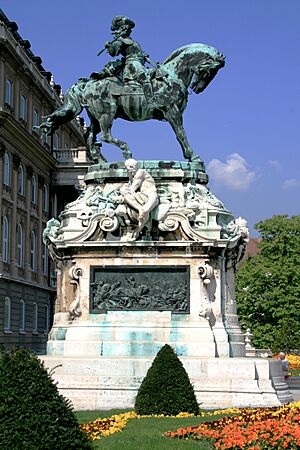
- A large statue of Eugene on horseback stands in the center of Vienna. It says, 'To the wise counsellor of three Emperors' and 'To the glorious conqueror of Austria's enemies'.
- Prinz-Eugen-Kapelle, a chapel in St. Stephen's Cathedral in Vienna.
- Prinz-Eugen-Straße, a street in Vienna since 1890. It connects Schwarzenbergplatz with the Wiedner Gürtel, passing the Belvedere Palace.
Warships
Several ships have been named in Eugene's honor:
- SMS Prinz Eugen, an Austro-Hungarian battleship from WWI.
- SMS Prinz Eugen, an Austro-Hungarian Ironclad warship built in 1870.
- HMS Prince Eugene, a Royal Navy monitor.
- Eugenio di Savoia, an Italian light cruiser.
- German cruiser Prinz Eugen (later USS Prinz Eugen), a World War II heavy cruiser.
Arms
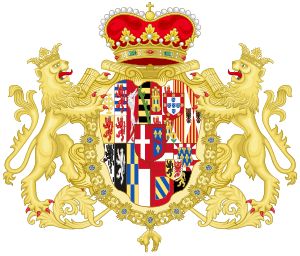 |
See also
 In Spanish: Eugenio de Saboya para niños
In Spanish: Eugenio de Saboya para niños
- Prinz Eugen, der edle Ritter
- 20 euro Baroque commemorative coin
- Louis William, Margrave of Baden-Baden
- Leopold I, Holy Roman Emperor


